John De Baun (1852–1912) was an American-born Australian real estate developer, hotelier and mining investor.
John De Baun (1852–1912) was an American-born Australian real estate developer, hotelier and mining investor.
John de Baun was born on 19 January 1852 in New Jersey. [1] [2] [3] [4] [5] He emigrated to Australia, arriving in Melbourne in the 1880s. [1] [2] [5]

New Jersey is a state in the Mid-Atlantic and Northeastern regions of the United States. It is located on a peninsula, bordered on the north and east by the state of New York, particularly along the extent of the length of New York City on its western edge; on the east, southeast, and south by the Atlantic Ocean; on the west by the Delaware River and Pennsylvania; and on the southwest by the Delaware Bay and Delaware. New Jersey is the fourth-smallest state by area but the 11th-most populous, with 9 million residents as of 2017, and the most densely populated of the 50 U.S. states; its biggest city is Newark. New Jersey lies completely within the combined statistical areas of New York City and Philadelphia. New Jersey was the second-wealthiest U.S. state by median household income as of 2017.

Melbourne is the capital and most populous city of the Australian state of Victoria, and the second most populous city in Australia and Oceania. Its name refers to an urban agglomeration of 9,992.5 km2 (3,858.1 sq mi), comprising a metropolitan area with 31 municipalities, and is also the common name for its city centre. The city occupies much of the coastline of Port Phillip bay and spreads into the hinterlands towards the Dandenong and Macedon ranges, Mornington Peninsula and Yarra Valley. It has a population of approximately 4.9 million, and its inhabitants are referred to as "Melburnians".
He lived and worked in Balranald for six weeks and then moved to Wilcannia, where he worked as a contractor. [1] In 1884 he established the first hotel in Silverton, [2] [3] The Silverton Hotel. De Baun also served as an alderman on the Silverton Council. In the wake of the gold rush in Broken Hill, he built another successful hotel, The Grand Hotel, in 1888. [1] [2] He also started investing in the Adelaide Stock Exchange and was worth £100,000 at one point, a large sum of money at the time. [1] [2] [3] He also invested in property in Broken Hill and Adelaide. [1] However, in 1892, he lost his fortune due to an economic downturn in the economy of Eastern Australia, and was only worth £5,000. [1] [2]

Balranald is a town and local government area in the Riverina district of New South Wales, Australia.
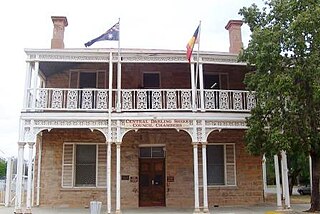
Wilcannia is a small town located within the Central Darling Shire in north western New South Wales, Australia. This was the third largest inland port in the country during the great river boat era of the mid-19th century. At the 2016 census, Wilcannia had a population of 549.

Silverton is a small village at the far west of New South Wales, Australia, 26 kilometres (16 mi) north-west of Broken Hill. At the 2006 census, Silverton had a population of 89.
Taking a chance on the gold rush in Coolgardie, Western Australia, he established four businesses in that town and became wealthy again, re-investing his resources in the stock market. [1] [2] He then built the Great Western Hotel in Coolgardie (now demolished). [1] [2] [6]
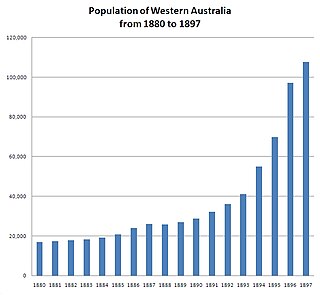
In the latter part of the nineteenth century, discoveries of gold at a number of locations in Western Australia caused large influxes of prospectors from overseas and interstate, and classic gold rushes. Significant finds included:
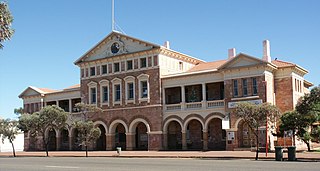
Coolgardie is a small town in Western Australia, 558 kilometres (347 mi) east of the state capital, Perth. It has a population of approximately 850 people.
In 1894 he purchased the Freemason's Hotel, on the corner of St Georges Terrace and William Street, Perth. He then built a new three-storey hotel, the Palace Hotel, designed by architects Porter and Thomas (formerly of Broken Hill), on the site. The Palace Hotel was called "one of the most beautiful and elegant hotels in Australasia" by author Warren Bert Kimberly. [1] [2] [5]

St Georges Terrace is the main street in the city of Perth, Western Australia. It runs parallel to the Swan River and forms the major arterial road through the central business district.

William Street is a suburban distributor and one of two major cross-streets in the CBD of Perth, Western Australia. Commencing in western Mount Lawley it also crosses the Perth to Fremantle railway at the Horseshoe Bridge. It is a one-way street from Brisbane Street to Newcastle Street, from which point until its terminus at The Esplanade it has been progressively converted to two-way since 2008. Its route takes it through the Northbridge cafe and nightclub district as well as Perth's central business district. A ramp which took William Street traffic from The Esplanade onto the southbound Kwinana Freeway was closed in 2004 during the construction of the Esplanade railway station.

The Palace Hotel in Perth, Western Australia is a landmark three-storey heritage listed building located in the city's central business district. Originally built in 1897 as a hotel during the gold rush period of Western Australia's history, it was converted to banking chambers and offices in the 1980s and now accommodates the Perth headquarters of Woods Bagot, Adapptor and Hatchd. The building is located on the most prominent intersection in the financial district of the city, at the corner of St Georges Terrace and William Street.
In 1896, he purchased the Retreat Inn on the corner of Hay and Milligan Streets, in Perth, and demolished it. [2] On the site he built a new two-storey hotel, The Melbourne Hotel, designed by architect Peter John Wilson. [1] [2] [5] [7] [8] He also owned many properties in Perth, including most of St Georges Terrace,[ disputed ] and mining interests in the Goldfields. [1] [5] Additionally, he owned prospecting rights in Cue. [1]

Hay Street is a major road through the CBD of Perth, Western Australia, and adjacent suburbs. The street was named after Robert William Hay, the Permanent Under Secretary for Colonies. Sections of the road were called Howick Street and Twiss Street until 1897. One block in the central CBD section is now a pedestrian mall with extremely limited vehicular traffic, so that it is necessary to make a significant detour in order to drive the entire length of Hay Street.

Milligan Street is a street in Perth, Western Australia that runs from St Georges Terrace to north of Wellington Street. The northern section provides access to the Perth Arena carpark and Telethon Avenue; there are also dedicated Transperth bus roads connecting to the northern end, south of the Fremantle railway line.
Peter John Wilson (1869–1918) was an Australian architect, known for a number of buildings in Western Australia.
In 1902 De Baun leased the Palace Hotel to John Glowrey, a member of parliament, [9] which allowed him to pursue interests in the Western Australian pearling industry. In December 1908 De Baun lost six ships (one schooner and five luggers) when a cyclone hit the Broome area. [10]
John Thomas Glowrey was an Australian politician who served as a member of the Legislative Council of Western Australia from 1900 to 1904 and again from 1906 to 1912.
A schooner is a type of sailing vessel with fore-and-aft sails on two or more masts. The most common type has two masts, the foremast being shorter than the main. While the schooner was originally gaff-rigged, modern schooners typically carry a Bermuda rig.
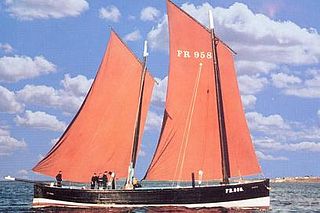
A lugger is a class of boat, widely used as traditional fishing boats, particularly off the coasts of France, England and Scotland. It is a small sailing vessel with lug sails set on two or more masts and perhaps lug topsails.
On 13 September 1899 De Baun married Ada Williams at St George's Cathedral, with the reception held at the Palace Hotel. [11]
De Baun died on 24 December 1911 in Perth, [3] [12] [13] following a blood infection in his leg, which was complicated by his diabetes.

Patrick "Paddy" Hannan was a gold prospector whose lucrative discovery on 14 June 1893 near Kalgoorlie in Western Australia set off a major gold rush in the area.

Norseman is a town located in the Goldfields-Esperance region of Western Australia along the Coolgardie-Esperance Highway, 726 kilometres (451 mi) east of Perth and 278 metres (912 ft) above sea level. It is also the starting point of the Eyre Highway, and the last major town in Western Australia before the South Australian border 720 kilometres (447 mi) to the east. At the 2016 census, Norseman had a population of almost 600.

Civil disturbances in Western Australia include race riots, prison riots, and religious conflicts – often Protestant versus Catholic groups.

A coffee palace was an often large and elaborate residential hotel that did not serve alcohol, most of which were built in Australia in the late 19th century. 'Temperance hotels' were first established in the UK in the 1850s to provide an alcohol-free alternative to corner pubs and residential hotels, and by the 1870s they could be found in every town and city, some quite large and elaborate. In the late 1870s the idea caught on in Australia, where the appellation 'coffee palace' was almost universal, and dozens were built in the 1880s and early 1890s, including some of the largest hotels in the country. Due to the depression of the later 1890s, some became ordinary hotels and others were converted to different uses. The name continued to be applied to smaller residential hotels and guest houses in the early 20th century, until the trend died out.

The Goldfields Water Supply Scheme is a pipeline and dam project that delivers potable water from Mundaring Weir in Perth to communities in Western Australia's Eastern Goldfields, particularly Coolgardie and Kalgoorlie. The project was commissioned in 1896 and was completed in 1903.
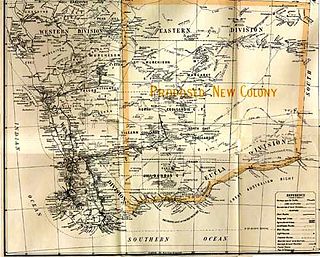
Auralia was a proposed colony that would have been formed out of the south-eastern portion of the colony of Western Australia in the early twentieth century, and would have joined the newly formed Commonwealth of Australia.

Charlie Tyson was an Australian rules footballer who played with Collingwood and North Melbourne in the Victorian Football League during the 1920s.
Sir Laurence "Brodie" Brodie-Hall was an influential figure in the mining industry of Western Australia (WA).
Australian rules football has been played in the Goldfields region of Western Australia since the late 1890s, when the Western Australian gold rush brought an influx of immigrants from Victoria and South Australia, bringing the sport with them.
State Batteries in Western Australia were government owned and run ore-crushing facilities for the gold mining industry. Western Australia was the only Australian state to provide batteries to assist gold prospectors and small mines. They existed in almost all of the mineral fields of Western Australia.
Jonas Alfred Lipman, frequently referred to as "Alf" or "Alfred", was an actor, producer and director of theatre and film of Melbourne, Australia. He was described as "a colourful extrovert" with "a flair for the wheeling and dealing of the film trade".
William Henry Leeder was an early settler in the Swan River Colony, Western Australia. He was granted a parcel of land that now includes the suburb of Leederville, which was named after him.

The Melbourne Hotel is a heritage listed landmark hotel in Perth, Western Australia. The hotel is located on the corner of Hay Street and Milligan Street.

The Palace Hotel is one of a group of heritage hotels on Hannan Street in Kalgoorlie, Western Australia.
Alfred Thomas "Alf" Chandler was a journalist, editor and newspaper proprietor in Victoria, South Australia and Western Australia. He was prominent in the Western Australian secession movement.
The Coolgardie Miner was a weekly newspaper established in Coolgardie, Western Australia, at a time when Coolgardie was the prominent town in the goldfields region of Western Australia.

Andrew Oswald Wilson (1866–1950) was an early-20th-century Western Australian architect. Born and trained as a carpenter in Victoria, he moved first to Perth and then to the goldfields, where he worked for Murdock McKay Hopkins. One of his best-known buildings is the Boulder town hall, for which he submitted designs in 1907. In 1908 he moved back to Perth and practiced from Forrest Chambers.
Francis Ambrose Moss was a mine manager in Perth, Western Australia.